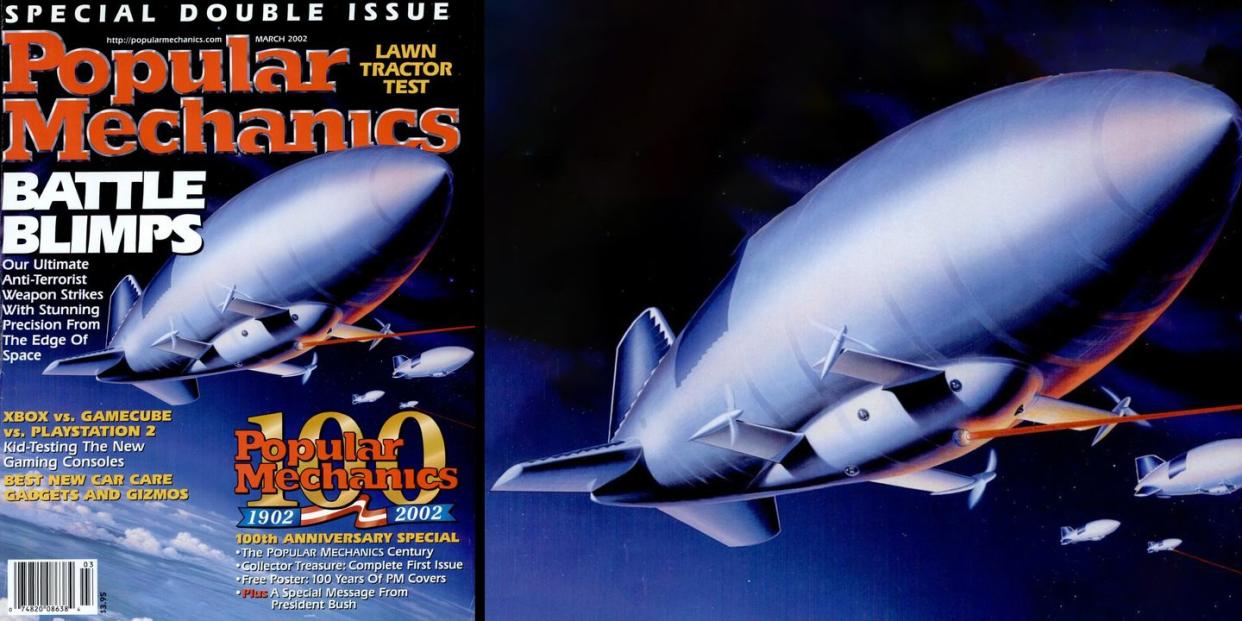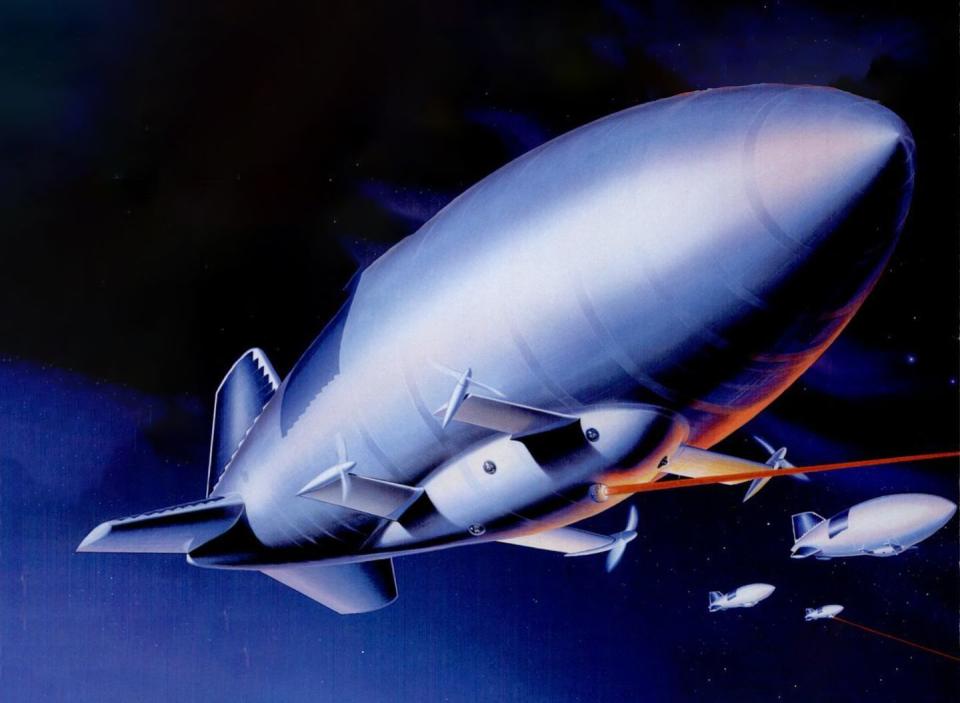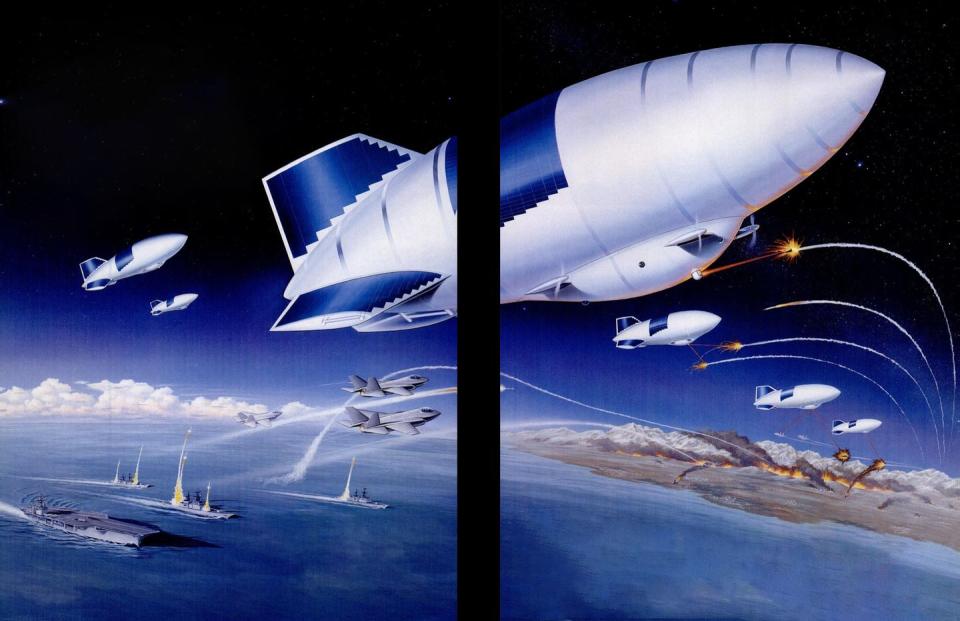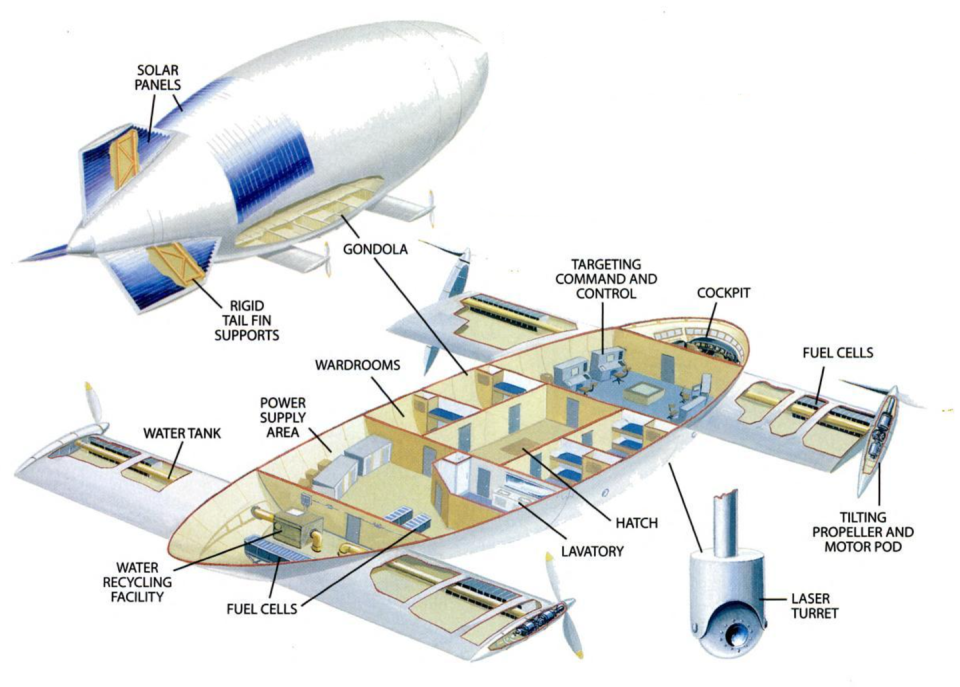21st Century Airships Are the Ultimate Weapon in the War on International Terrorism


In the March 2002 issue, Popular Mechanics explored the return of an all military weapon system—the battle blimp. While lighter-than-air aircraft had been used in battle since the Civil War, blimps never found much use in the atomic era. In the early 2000s, things had changed and blimps seemed like a great option for battling international terrorism. The idea never really took off, but its core idea of blimps powered by solar power could still find a place in the skies in the near future.
Of the thousands of men who volunteered to fight in the Civil War, none offered their services with the panache of Thaddeus Sobieski Constantine Lowe. Suspended beneath a hydrogen-filled balloon floating 500 ft. above Washington, D.C., Lowe sent this message to President Lincoln: "Sir, I take great pleasure in sending you this first dispatch ever telegraphed from an aerial station."
More than 140 years after that afternoon on June 17, 1861, a new generation of high-altitude, heavy-lift airships is emerging. Equipped with sophisticated ground-tracking, radar, and defended with laser cannons, these 21st century battle blimps could become a crucial weapon in the war on international terrorism.
Hovering high above the fray for weeks on end, they could economically monitor enemy troops and point the laser designators that guide cruise missiles and smart bombs, released from ships and conventional warplanes, toward elusive moving targets.
"The desire to have an electronic payload in the stratosphere has been with us almost since the invention of aviation," said Per Lindstrand, founder of Lindstrand Balloons of Oswestry, England. Located between 11 and 13 miles above sea level, the stratosphere is above all weather and is almost moisture-free.
"It is also the calmest part of the atmosphere, which is very important for geostationary flight," Lindstrand said at the 14th American Institute of Aeronautics and Astronautics Lighter-Than-Air Systems Convention and Exhibition in Akron, Ohio, this past summer.
The First Battle Blimps

As part of Operation Plumbbob tests conducted in 1957, the Atomic Energy Commission (AEC) hung nuclear weapons as large as 74 kilotons beneath blimps. The nuclear balloon era came to a close in 1963 after a pair of freak accidents destroyed the AEC's two airships on two consecutive days. On that Saturday, April 20, a blaze caused by a loose gas cap on a motor-generator set fire to an airship moored overhead. The next day, a lightning strike caused the cable to break on the second airship. It drifted across the Nevada weapons test range and out of sight of ground crews, never to be seen again.
While the AEC was experimenting with using airships to lift nuclear weapons, the Air Force was in the midst of Operation Moby Dick. This was an attempt to photograph Soviet military installations from altitudes over 100,000 ft., safely above the range of surface-to-air missiles. An internal study written in 1957, and classified secret for 40 years, concluded that free-floating balloons could not accurately photograph small targets. The job of watching our adversaries was eventually turned over to U-2 and SR-71 aircraft, and later satellites.
The military has known how to lift payloads as heavy as 15 tons into the stratosphere for nearly half a century. In the spring of 1960, Goodyear Aircraft—now part of Lockheed Martin—went public with a proposal to enlarge the 80-ft. ZPG-3W airship it built for the U.S. Navy to nearly the length of two football fields. The unnamed craft would have carried 110,000 pounds.
Geostationary operation in the stratosphere permits radar and other observation systems perfected for satellites to operate at 10 to 50 times the resolution of the view from space, providing highly detailed battlefield images. During tests conducted over Kosovo in November 2000, for example, the United Nations successfully demonstrated that synthetic aperture radar hung beneath a small commercial airship—the sort used for advertising-could detect buried land mines and even live hand grenades.
"The results of the radar trial in Kosovo exceeded those expected," Simon Christoforato, of the British Defence Evaluation and Research Agency, told the Akron conference.
Power To Burn

The second key to the revival of the battle blimp is power. Here, NASA engineers and contractors have played the starring role by solving the problem that, at least publicly, stumped military designers during the early years of the Star Wars missile defense program. At that time, blimps were envisioned as platforms for testing lasers that would eventually shoot down Soviet missiles in space.
In the early 1980s, the Pentagon funded a design study of a battle blimp powered by four piston engines, fueled with liquid hydrogen."This obviously meant frequent refueling, which is undesirable as 90 percent of all airship accidents happen during the docking phase," Lindstrand said. The Star Wars blimp was never built.
NASA approached the fuel problem by looking to the sun. It financed research into the development of high-efficiency-30 percent plus solar cells and, later, lightweight fuel cells. This work was eventually incorporated into NASA's Helios program which involved building a long-endurance, high-altitude drone for atmospheric research.
Inside the Battle Blimp
Future battle blimps will draw heavily on technology, such as solar cells and fuel cells developed for aerial cellphone relay stations and laser cannons designed for missile defense.

During daylight hours, high-efficiency solar cells power electric motors for propulsion. Surplus electricity is used to break water down into hydrogen and oxygen, which is then stored. At night the gases are recombined in a fuel cell, producing electricity and water, which is used the following day. In an airship, the combination of solar cells and fuel cells provides an additional benefit. As the lifting bag leaks—all such bags eventually leak-lost helium is simply replaced with lighter hydrogen.
"A lot of NASA Helios technology has found its way into what we are doing," Charles K. Lavan Jr. tells Popular Mechanics. He is the principal engineer for advanced programs at Lockheed Martin Naval Electronics and Surveillance Systems in Akron. The company has designed a high-altitude airship that can carry telephone- and Internet-switching equipment. Lavan heads a team that has come up with a design that uses nacelle-mounted, brushless DC motors to keep a blimp"on station." Hydrogen and oxygen are stored in hollow tail-structure tubes-and there will be plenty to store.
High efficiency solar cells operate even better at high altitudes, Lavan explains. The net result is that sufficient power for both telecommunications gear and station-keeping can be obtained by covering only the tail assembly with solar cells. To satisfy the higher power requirements for radar and laser designators, and perhaps someday defensive laser cannons, designers could extend solar cell coverage over more of the airship.
Exactly how far the United States has progressed in developing a 21st century battle blimp remains a matter of speculation. The most advanced work is highly classified. Some attribute UFO sightings to a massive military balloon that has the ability to mask itself by displaying on its undercarriage a montage of stars that duplicate those overhead. What is known for certain is that the more expensive the war on international terrorism grows, the more vital the "aerial station" Lowe offered President Lincoln will become.
You Might Also Like

